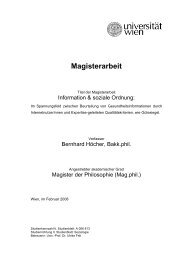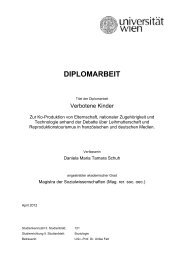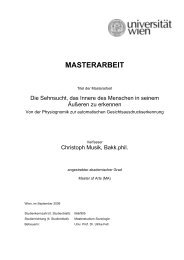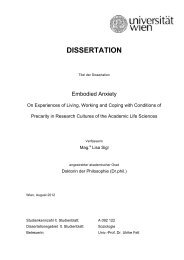MASTERARBEIT - Institut für Wissenschaftsforschung - Universität ...
MASTERARBEIT - Institut für Wissenschaftsforschung - Universität ...
MASTERARBEIT - Institut für Wissenschaftsforschung - Universität ...
Create successful ePaper yourself
Turn your PDF publications into a flip-book with our unique Google optimized e-Paper software.
METHODOLOGY AND MATERIALS<br />
In order to achieve the goals I have set for the theoretical aspect of<br />
my thesis, a sound methodological approach is a central requirement<br />
to be met. Also, as I claimed an approach using a clear theoretical<br />
framework and a structured analysis to be missing in the discourse<br />
about the zeppelin’s popularity. Hence the methodological approach<br />
is of course an important one for my study to achieve its goals of<br />
providing exactly that and thereby cotributing something previously<br />
lacking.<br />
5.1 methodology<br />
The methodology for my study comes with the SCOT approach. It<br />
is already introduced in the origins of SCOT from 1984 [40]. Bijker<br />
provides a clearer account of the methodological approach to a SCOT<br />
study in his piece »How is technology made? -That is the question!« from<br />
2010 [3]. He describes a three-step process consisting of:<br />
Step 1: analysis of the artifact to regarding its interpretative<br />
flexibility and relevant social groups active in its<br />
construction<br />
Step 2: a description of the process of social construction<br />
of the artifact<br />
Step 3: an explanation how and why this construction<br />
process worked with regards to technological frames of<br />
relevant social groups<br />
I would like to mostly stick with these steps. Giving more detailed<br />
instructions, the methodology is described as followed:<br />
»Key concepts in the first step are ‘relevant social group’<br />
and ‘interpretative flexibility’. [. . . ] relevant social groups<br />
can be identified by looking for actors who mention the<br />
artefact in the same way. [. . . ] Because the description<br />
of an artefact through the eyes of different relevant social<br />
groups produces different descriptions—and thus different<br />
artefacts—this results in the researcher’s demonstrating<br />
the ‘interpretative flexibility’ of the artefact.« [3, 68]<br />
This step Bijker describes is somewhat redundant, at least for I am<br />
going to do. As my interest lies in the STI connected to the zeppelin,<br />
41<br />
5







